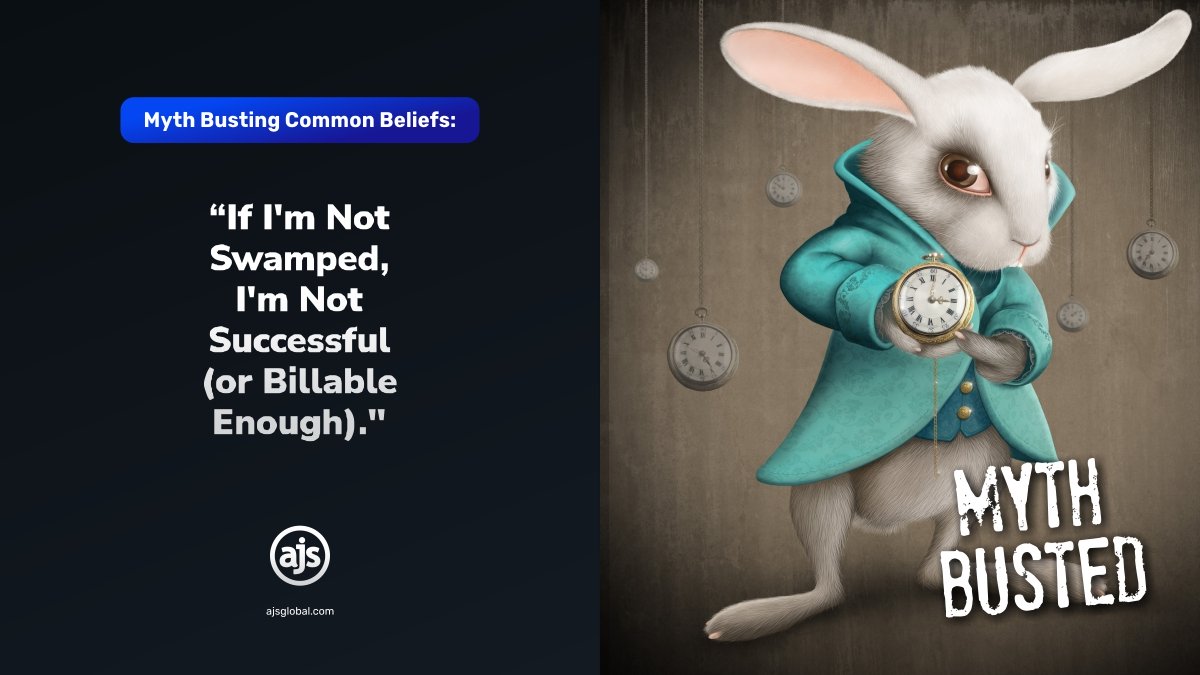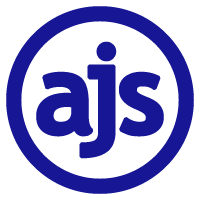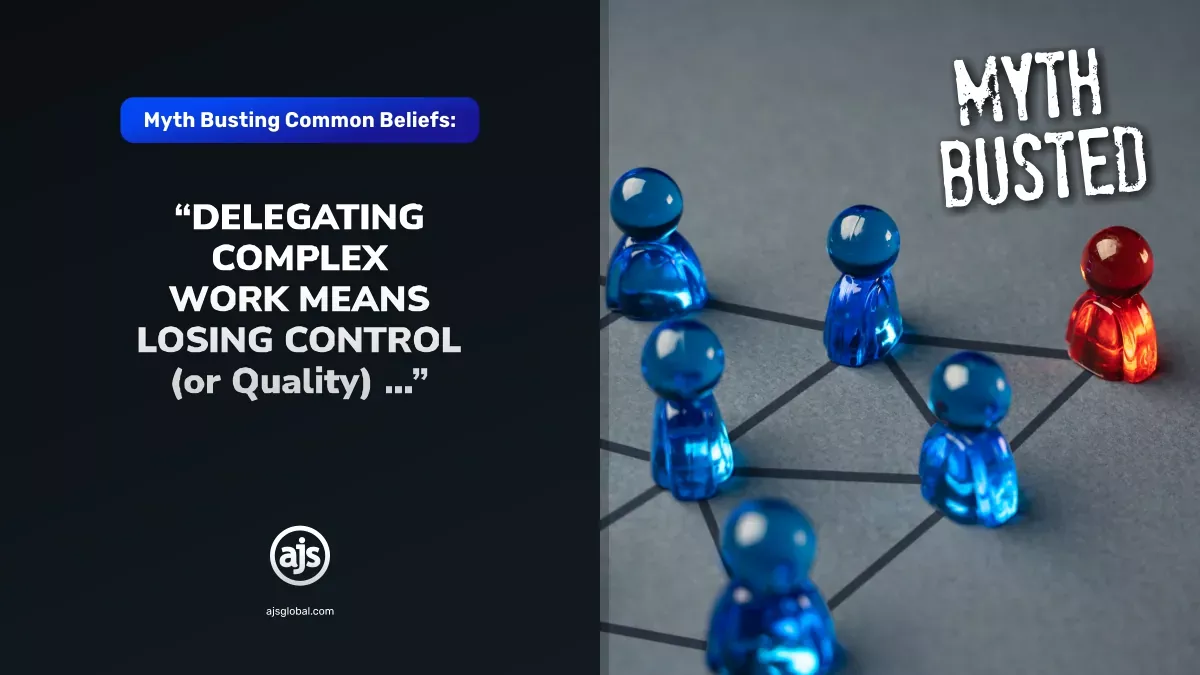
MYTH BUSTING COMMON BELIEFS: Part 10
Like “If I’m Not Swamped, I’m Not Successful (or Billable Enough).”
“I’m late, I’m late for a very important date. No time to say hello, goodbye. I’m late, I’m late, I’m late!” was famously said by the White Rabbit in Lewis Carol’s Alice in Wonderland. And it always makes one think of a very, very busy rabbit who has no time – even for the pleasantries.
Now who is that busy, one may ask?
And as coincidence would have it, a lot of us are.
When you ask the average lawyer, no actually the average person, how they’re doing, their common response is “Busy” and to our surprise the common response to that is “Busy’s good.” As if it’s normal. No, it’s more than that. As if being busy out of your mind, not knowing whether you are Arthur or Martha, not knowing which way is up – is what you should be working for. Almost as if “busyness” should be worn like a badge of honour.
And for a lot of lawyers and legal practitioners, not running around like headless chickens makes them feel like they aren’t billing enough. Not doing enough. Not successful or not succeeding.
In fact, in the article Hard Work doesn’t always lead to Success, the following was set out –
Hard work has been romanticized since corporations existed. In the business world, idioms about how sleep is for the weak or how no amount of talent can supersede hard work were doled out for decades. The underlying assumption was that if you worked hard enough for long enough, you would succeed. However, this advice misses one big point: Most people fail not because of a lack of effort but because their effort was misdirected or misaligned with their interests.
Further to the above and in research conducted by Columbia University titled Conspicuous Consumption of Time: When Busyness and Lack of Leisure Time Become a Status Symbol, the authors conclude that –
“positive status inferences in response to long hours of work and lack of leisure time are mediated by the perceptions that busy individuals possess desired human capital characteristics (competence, ambition), leading them to be viewed as scarce and in demand.”
The Downside of being too busy
In a Forbes article titled Why Many New Leaders Become Too Busy To Win, author Dr. Nicole Lipkin writes about the psychology of work and leadership. And what is so striking is that sometimes “busyness” makes someone so lost in the forest that they can no longer see the trees. In this need to keep up and keep oneself “busy” and productive and seemingly important, we inadvertently become too busy to win. And that is a whole other can of worms.
And look being busy in and of itself, is not a bad thing. The problem arises when you take on too much. Especially when it’s for the wrong reasons.
But it’s not entirely an individual’s fault really. With the hustle culture what it is, we are constantly bombarded with hustle memes like:
- Hustle never sleeps.
- If you want to make it to the top, you have to hustle.
- Good things come to those who hustle.
- Hustle until haters ask if you’re hiring.
And this is where things start to get unhealthy.
Because the hustle culture confuses constant activity with genuine achievement. And this mindset often leads to burnout, poor outcomes, and a constant feeling of inadequacy, that’s masking true inefficiency.
Why busyness is mistaken for success
The belief that “busy is good” is rooted in several social and psychological factors.
- Perception of importance – society often equates a lack of leisure time with high status and ambition. When we see a colleague who is constantly busy, we assume they are in demand, important, and highly competent.
- Dopamine rewards – checking items off a long to-do list provides a momentary feeling of accomplishment as the brain releases dopamine. This can become an addictive cycle, pushing us to seek out more tasks simply to experience the pleasure of completing them, regardless of their value.
- Fear of idleness – for some, being busy serves as a coping mechanism to avoid painful thoughts, feelings, or underlying insecurities. A quiet moment for reflection may feel frightening or uncomfortable, making constant activity a welcome distraction.
- Illusion of productivity – abusy schedule creates the facade of productivity. However, much of this frantic activity is “busywork”—low-impact, meaningless tasks that don’t contribute to long-term goals.
- Rewarding activity, not results – in some workplaces, employees are inadvertently rewarded for long hours and high activity rather than for the quality or strategic impact of their work. This drives a “busy game” where employees feel compelled to constantly appear active.
The consequences of the busy trap
- Burnout – a relentless, overbooked schedule without proper rest depletes energy and leads to chronic stress. This reduces focus, damages physical and mental health, and is a key driver of employee turnover.
- Ineffectiveness – as we mentioned briefly above,busyness often masks inefficiency. Multitasking and rapid task-switching prevent the deep, focused work required for innovation and high-quality output. Turns out that being able to multitask is great, having to is not the best idea.
- Stagnation – filling your days with low-impact tasks leaves no room for the strategic thinking, growth opportunities, and skill development that drive true progress. If you want to truly succeed and be able to bill for quality work, focusing on the more intense work and leaving the labour intensive, “routine,” “busy” work to legal tech.
- Poor relationships – constant busyness leaves little time for deep, meaningful connections with family and friends. Nurturing these relationships is essential for a fulfilling life but often falls by the wayside. Here it’s so important to remember that you can be replaced at work – because no one is in fact irreplaceable – but you can’t be replaced at home.
- Loss of purpose – when we focus solely on completing tasks, we can lose sight of the bigger picture and the “why” behind our work and our career starts to fall away. This can make even impressive accomplishments feel empty.
How to shift from busyness to true productivity
Breaking the “swamped means successful” and busy bee mindset requires re-evaluating your approach to work and to life. You can do this by –
- Focusing on outcomes, not activity – measure success by results and impact rather than by the number of hours you work or tasks you complete. As a lawyer who bills by the hour this can be tough to do. Which is why changing to retainers or fee-based work could be the way to go. Ask yourself regularly, “Will completing this task move me closer to my goals?”.
- Ruthlessly prioritising – use a framework like the Eisenhower Matrix to distinguish between urgent and important tasks. Learn to say “no” to low-impact tasks and focus your energy on what matters the most.
- Wait. What is the Eisenhower Matrix?
The Eisenhower matrix or Urgent-Important Matrix is a productivity tool that helps you prioritize tasks by categorizing them into four quadrants based on their urgency and importance: Urgent & Important, Important & Not Urgent, Urgent & Not Important, and Not Urgent & Not Important. The goal is to focus on Quadrant 1 (Urgent & Important) tasks immediately, schedule Quadrant 2 (Important & Not Urgent) tasks for later, delegate Quadrant 3 (Urgent & Not Important) tasks, and eliminate Quadrant 4 (Not Urgent & Not Important) tasks.
- Practicing “deep work” – block out uninterrupted time for cognitively demanding high-impact tasks. Avoid multitasking, which fragments your attention and diminishes the quality of your work.
- Scheduling rest – treat breaks and rest as essential, non-negotiable appointments. Time off is crucial for avoiding burnout and restoring the mental and physical energy needed for high performance.
- Delegating effectively – for leaders, delegating is a powerful tool to free up time for strategic tasks while empowering team members to grow.
- Cultivate mindfulness – pay attention to your emotions and reflect on your actions. This awareness can help you identify when you are using busyness as a crutch and realign your efforts with your core values. It is also extremely powerful to practice self-reflection as often as you can.
How Legal Tech Can help you
Legal tech can help overcome the “If I’m Not Swamped, I’m Not Successful” mindset by shifting the focus from hours worked to efficiency and outcomes – a way healthier way to look at your success. By automating or streamlining many time-consuming, labour intensive, “busy” tasks, legal tech allows lawyers to produce high-quality work without being perpetually swamped, promoting a healthier and more sustainable measure of success.
And that’s the right kind of busy. A sustainable kind of busy. The kind of busy we can get behind.
Using legal tech to reframe success
- Reduce the focus on billable hours – for many lawyers, especially those at larger firms, success is measured by the number of hours they have billed. This leads to a mentality where working long hours is viewed as a virtue, even if much of that time is spent on low-value, repetitive tasks. Legal tech that will make a difference –
- Time-tracking software tracks time with greater accuracy, ensuring that all work is accounted for without lawyers having to stay late just to hit a target*.
- Practice management systems provide data-driven insights into how time is spent, allowing firms to focus on profitability rather than just increasing billable hours*.
- Automate routine and administrative tasks – a sizeable portion of a lawyer’s time is dedicated to non-billable, repetitive work that contributes to the feeling of being “swamped”. This can be alleviated through –
- Document automation tools generate standard documents like basic contracts, straightforward Applications, or wills using templates. This can significantly reduce drafting time and can almost entirely eliminate human error*.
- Client intake and customer relationship management (CRM) software automates the initial client intake process, saving time on data entry and manual communication – making the entire process as easy as pie*.
- AI-powered legal research and review can analyse massive amounts of data in seconds, reducing the time spent on manual review and research by up to 60%. And who wouldn’t want that automated??
- Improve workflow efficiency – clunky processes and a lack of organisation can make a manageable workload feel completely and utterly overwhelming. To fix this use –
- Cloud-based practice management software centralises case files, calendars, deadlines, and communications, providing a sole source of information that is accessible from anywhere (and with AJS) on almost any device*.
- Automated workflows can be created for specific tasks (e.g., client onboarding, document filing), reducing bottlenecks and ensuring that critical tasks are completed not only on time but properly too – fewer errors*.
- E-discovery platforms allow legal professionals to manage the vast data involved in litigation, which can cut document review times significantly. But legal professionals must be cautious here. They must always check and cite resources to ensure that there aren’t any AI hallucinations.
- Facilitate a better work-life balance – the belief that being swamped equates to success often comes at the expense of a healthy work-life balance, leading to burnout and high physical and mental breakdown rates. To prevent this, implement –
- Mobile-first solutions in practice management and communication allow lawyers to access files, track time, and communicate with clients from their mobile devices. This provides flexibility and the ability to work effectively from various locations*.
- Digital communication tools like client portals streamline updates and reduce the need for unscheduled phone calls or meetings, helping lawyers maintain professional boundaries and that is crucial in a world where we are always contactable and always available*.
- Data analytics can identify imbalanced workloads and burnout risks, allowing firms to distribute work more fairly and proactively address potential stress factors. As we have said, delegating is important and needs to be embraced (always reasonably and in the right circumstances) *.
- Measure success with data, not hours – by tracking key metrics with technology, firms and individual lawyers can focus on value, not just volume. And they can do this with –
- Business intelligence tools which can measure metrics like client satisfaction scores, revenue per client, and project turnaround time*.
- Performance data can show that a lawyer who uses technology to complete a task in 10 hours is more efficient and profitable than one who spends 20 hours doing it manually, reinforcing the value of strategic work*.
*All features readily available through AJS.
We think it’s important to reiterate that being busy in and of itself is not a bad thing. But being busy with mundane, routine and labour intensive “busy” work for the sake of looking busy (to meet some form of “ideal”) is unhealthy. Especially when legal tech, like that offered by AJS, is available to lighten the load.
Simply working harder and increasing your efforts in order to achieve a – probably unattainable, unrealistic – goal isn’t the answer. The right thing here is to consider whether your hard work is rightly directed or if you may be putting in too much work for things that have minor impact. And then acting accordingly.
It’s at this point that we think the answer to this conundrum is plain for all to see – the myth about not being swamped meaning you aren’t successful is BUSTED! Not only because it isn’t true. But also, because it’s unhealthy.
We leave you with one more thought – True success is not measured by the length of your to-do list but by the impact of your work and a balanced, intentional life.
If you are in need of a service provider who has a proven track record or if you want to find out how to incorporate a new tool into your existing practice management suite – or if you simply want to get started with legal tech – feel free to get in touch with AJS. We have the right combination of systems, resources, and business partnerships to assist you with incorporating supportive legal technology into your practice. Effortlessly.
AJS is always here to help you, wherever and whenever possible!
– Written by Alicia Koch on behalf of AJS
(Sources used and to whom we owe thanks – Assembly Software; Rocket Matter; Clio; Ramit Sethi; Harvard Business Review; CultureWise; Forbes and Columbia Research Paper)




Leave a Reply